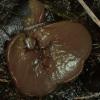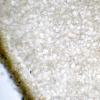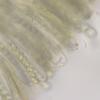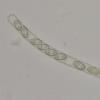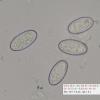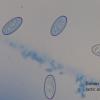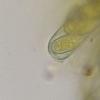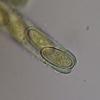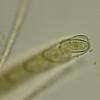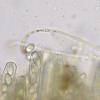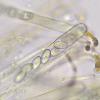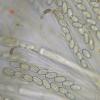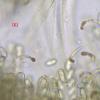
28-12-2025 12:08
Margot en Geert VullingsThis possible Karstenia was found on the bark of d

21-12-2025 21:32
Pol DebaenstHello, Garden, Burgweg 19, Veurne, BelgiumOn 10/1

26-12-2025 21:19
Arnold BüschlenPithyella chalaudii Priou. Ist als Bryoparasit in

21-12-2025 09:32
Hello.A tiny ascomycete found embedded in wood in

18-12-2025 21:17
Pol DebaenstThe identification took me to Byssonectria deformi

24-12-2025 17:08
Hulda Caroline HolteHello, I have found this propoloid ascomycete on
Peziza -> Lepidotia hispida
Margot en Geert Vullings,
28-09-2023 20:57
The fruit bodies are 2.5 cm in diameter and olive green in color.
The bottom is colored the same as the inside.
Spores: 14.6-16.1 x 6.6-7.9µ, in cotton blue-lactic acid not or very fine ornamented?
Ascus: 183.8-230.47 x 10-12µ
Everything measured in water.
Paraphyses: curved, walking stick, 3.5µ wide.
In Melzers no reaction on the ascustop.
With Spooner's key I cannot arrive at a species that fits correct. The closest is Peziza subviolacea in terms of spore sizes and ascus size, but lacks the violet color.
Which Peziza could this be?
Thanks in advance, Margot&Geert
Nicolas VAN VOOREN,
29-09-2023 08:14

Re : Peziza
Hello.
First, you should retry the test of amyloidity (sometimes it works with IKI instead of MLZ). The type of reaction is an important feature.
Then you can use the key to European genera of Pezizaceae available here: https://doi.org/10.25664/KEY-0009
It can help to find the best genus (or genera) for your collection.
First, you should retry the test of amyloidity (sometimes it works with IKI instead of MLZ). The type of reaction is an important feature.
Then you can use the key to European genera of Pezizaceae available here: https://doi.org/10.25664/KEY-0009
It can help to find the best genus (or genera) for your collection.
Margot en Geert Vullings,
29-09-2023 13:54
Re : Peziza
Thanks for the response Nicolas.
We currently do not have IKI, but we would like to order it.
We currently do not have IKI, but we would like to order it.
The question is whether we will receive it in time for this cup fungus.
Regards, Margot
Nicolas VAN VOOREN,
29-09-2023 14:38

Re : Peziza
So retry with MLZ :)
Margot en Geert Vullings,
29-09-2023 18:09
Nicolas VAN VOOREN,
29-09-2023 18:36

Re : Peziza
OK, this is a reaction of W type.
More information in this paper: https://doi.org/10.25664/art-0305
More information in this paper: https://doi.org/10.25664/art-0305
Margot en Geert Vullings,
29-09-2023 19:46
Re : Peziza
Thanks for all the information.
We are not familiar with all the terms of the key, we are beginners, but we tried it and ended up with Hansenopezia?
We are not familiar with all the terms of the key, we are beginners, but we tried it and ended up with Hansenopezia?
Nicolas VAN VOOREN,
30-09-2023 10:34

Re : Peziza
No, I don't think it could be a Hansenopezia.
The ascospores contain granules (BSG), not guttules. As the content of paraphyses is not easy to determine with your photos, the choice is between Elaiopezia or more probably Phylloscypha.
The ascospores contain granules (BSG), not guttules. As the content of paraphyses is not easy to determine with your photos, the choice is between Elaiopezia or more probably Phylloscypha.
Margot en Geert Vullings,
30-09-2023 20:49
Nicolas VAN VOOREN,
01-10-2023 09:11

Re : Peziza
Interesting.
Well, using my key, the genus Elaiopezia could fit, but I don't know any species with these characters.
Another possibility is the genus Lepidotia. The ecology and all the microscopic characters agree with L. hispida, but this species is usually stipitate!
Sequencing the collection will probably give the solution.
Well, using my key, the genus Elaiopezia could fit, but I don't know any species with these characters.
Another possibility is the genus Lepidotia. The ecology and all the microscopic characters agree with L. hispida, but this species is usually stipitate!
Sequencing the collection will probably give the solution.
Margot en Geert Vullings,
01-10-2023 13:49
Re : Peziza
We don't know anyone who could sequence this for us. If you are interested, we will be happy to send you the cup mushroom?
Kind regards, Margot &Geert
Kind regards, Margot &Geert
Nicolas VAN VOOREN,
29-01-2024 10:48

Re : Peziza
The sequences obtained from this collection confirm this is Lepidotia hispida.
Margot en Geert Vullings,
29-01-2024 11:32
Re : Peziza -> Lepidotia hispida
Thank you very much Nicolas, we are very happy with this determination!
Registered as a new species for the Netherlands.
Kind regards,
Margot&Geert
